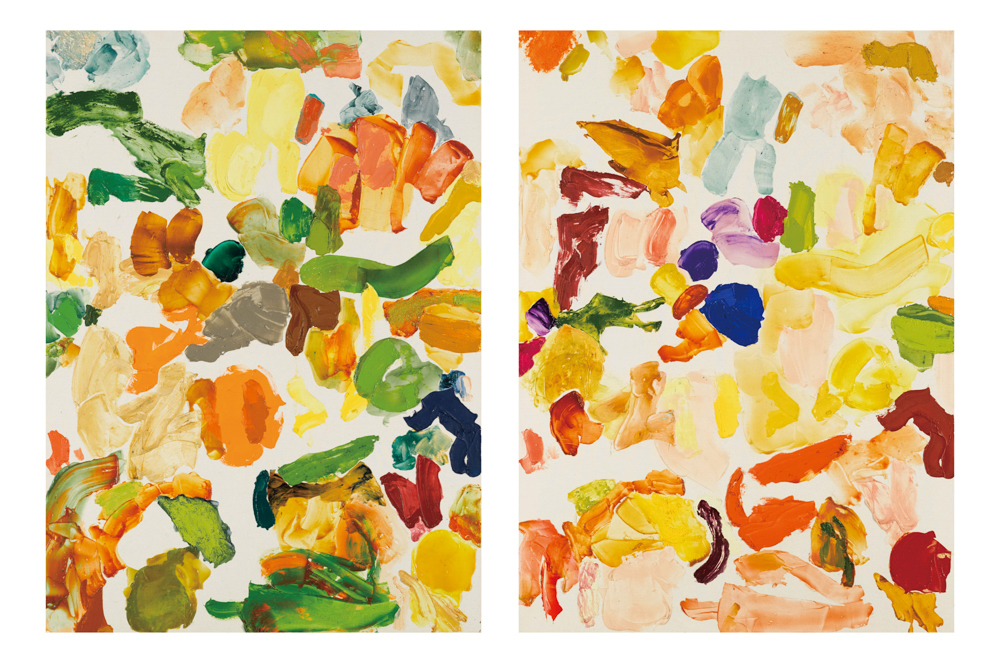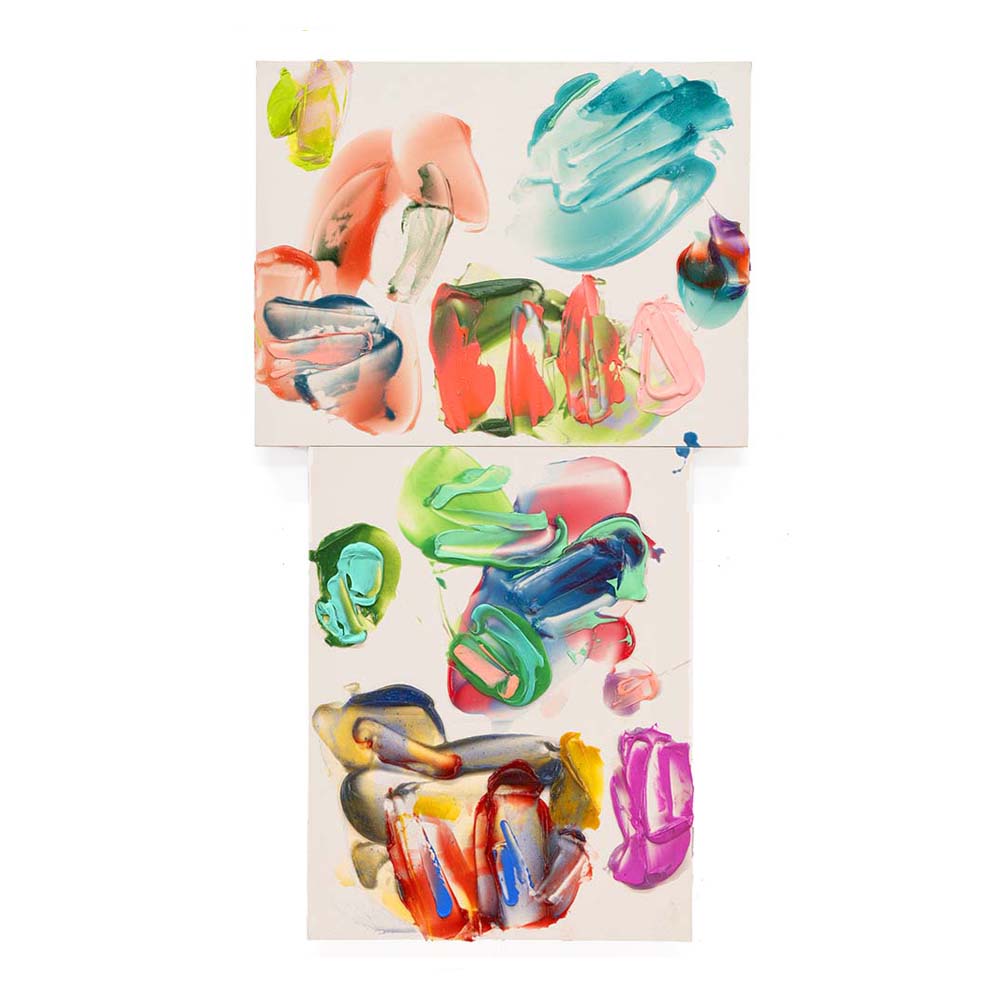KENJIRO OKAZAKI: TIME UNFOLDING HERE
HAPPENINGText: Alma Reyes
A small room displays Okazaki’s Picture Books, which he claims are the “ultimate format for expressing the world’s plurality and complexity.” The artist sees a sense of independence through the sequence of double-page spreads and hidden pages. The childlike drawings breathe endearment and innocence.
A unique element in Okazaki’s polychromatic paintings is the accompanied lengthy titles that are meant to be expressive sequences, with precise character counts and proportions corresponding to the canvas ratios. The captions read like narratives, describing body parts verbalizing emotion, living creatures interacting with the wind, fire, water, sun, earth, rain, clouds, flowers, or merely day-to-day activities. The connection between art and words procreates space and time, and epitomizes Okazaki’s strong penchant for literature.

Kenjiro Okazaki, Left: The little village on the far mountainside was already out of sight, and spring was coming around again. The grape trees were like large ailing snakes creeping under the coping stones of the wall. A brown light moved about in the tepid air. The void created by the selfsame every day is likely to chop down even the young trees that were left behind. In this everyday life, a thicket of trees protrudes like a boulder.
Right: The village I lived in has never been thought of as so small. The sun showed itself. The tall poplar forest looks like a beach being blown about by the wind. I grow dizzy just watching that seamless succession. If I can manage to get drunk on the succession of unchanging days, I can also grow to feel like I have taken down an elephant or snake. He differentiated things this way, like a fluttering butterfly., 2002, Museum of Contemporary Art Tokyo, Photo: Ichiro Otani
For instance, a set of two paintings from 1997 describes a metaphor of sensations that transpire while drinking coffee. During these years, Okazaki’s color application looked subtle and less congested as opposed to later works that gradually emit more powerful tones, such as in a double panel about a little village from 2002. and moreso, in the works after 2022. These also include the small, alluring “Zero Thumbnail” pieces.

Kenjiro Okazaki, What secrets lie within!” Moon pearls crowned garden walls. “Look how shadows dance!” Hark, Wind whispered phantom tales. “Stars sang memories deep.” “Time weaves silver dreams!” she shouted joyfully,”He lives!”
And from the mountains the echo came back upon her, “He lives!” “Is the spring coming?” Dawn mist cloaked emerald hills. “Do you have a garden?” Roses climbed ancient walls. “What makes the grass grow?” Rain whispered to the earth. “Where do old tales rest?” Time slept in shadows where moorland flowers bloom and fade., 2024, Photo: Shu Nakagawa
From 2022, Okazaki focused more intensely on the alternate placement of vertical against horizontal panels “to incorporate predetermined physical proportional relationships within the pictorial plane.” He further explained, “Like an astronaut floating in space, the painting does not establish any irreversible relationship between top and bottom. Connected panels, however, introduce proportional relationships between themselves into the composition. The transition of the gaze from one panel to another creates a spatial hierarchy with reversible dominant-subordinate relationships…” This is evident in a set of a horizontal and vertical canvas from 2024 narrating a dialogue among the stars, moon, wind, rain, and garden.

Kenjiro Okazaki, Heads poking out, a shape with lion body and man’s head. A gaze blank and pitiless as the sun. Embankment crowded, a vast image troubles my sight. Everyone shouting, voices affectionate, half-crying. We’re all gonna die. Darkness drops again. I heard ducks floating.
Black rocks absorbed light. Was I all along born on the far shore? Cave pitch dark. Colors fade. Stretch out a hand. World already ended.
Spread legs. Never to perish again. Only a presence – the subtle movement of air as someone searched. Solely ephemeral presence lingers. I remember who I am. Earthquake shook. Sun black as sackcloth. Moon like blood. Stars fell to earth, fig tree dropping unripe fruit. Sky split apart, mountains and islands moved. Kings, slaves shouted, “Hide us from the throne, from the Lamb’s wrath.” Their day has come. I’m gonna faint!, 2024, Courtesy of the artist and galerie frank elbaz, Paris, Photo: Shu Nakagawa
Moreover, in the latter years, he learned to unrestrict himself from limitations of size, scale and linear time. One notices a stronger and bolder impact of color fusions, and much thicker, convoluting brushstrokes. These are felt in a work combining two vertical and horizontal panels each from 2024, which evokes the correlation between the sea and the sky, as well as another from 2024 that mentions heads, black rocks, a cave, earthquake and moving mountains and islands. The parade of such large-scaled paintings, especially on the third floor is astounding. Chromatic splashes illuminate like jewel stones or abstract entities hovering in a choreographed movement, and discharge Okazaki’s re-energized soul.
Massive sculptures, like “The Salt Of The Sea, Rivers Fresh, Scales Lurking Below, Wings Soaring Above” (2024), absolutely embrace the essence of plasticity, which the artist defines as the “versatile bonding and composition of these particles of earth.” Okazaki’s world reinforces the resilience of material composition in all elements of nature, and synthesizes and compresses them in time and space.
Kenjiro Okazaki: Time Unfolding Here
Date: April 29th – July 21st, 2025
Opening Hours: 10:00 – 18:00
Closed on Mondays (except July 21st)
Place: Museum of Contemporary Art Tokyo
Address: 4-1-1 Miyoshi, Koto-ku, Tokyo
Tel: +81 (0)3 5245 4111
https://www.mot-art-museum.jp
Text: Alma Reyes





